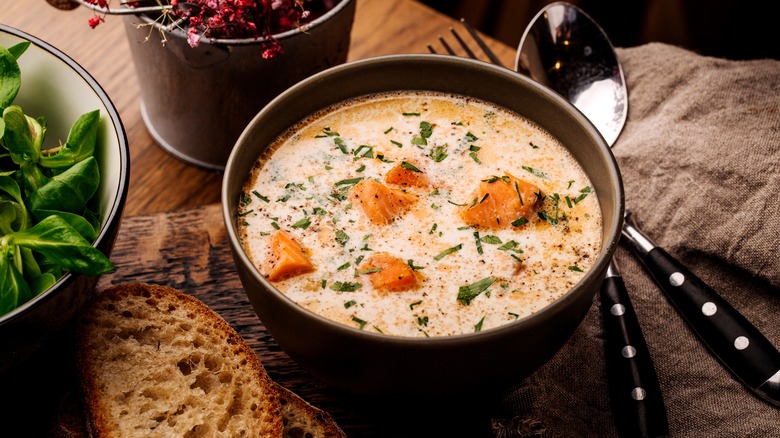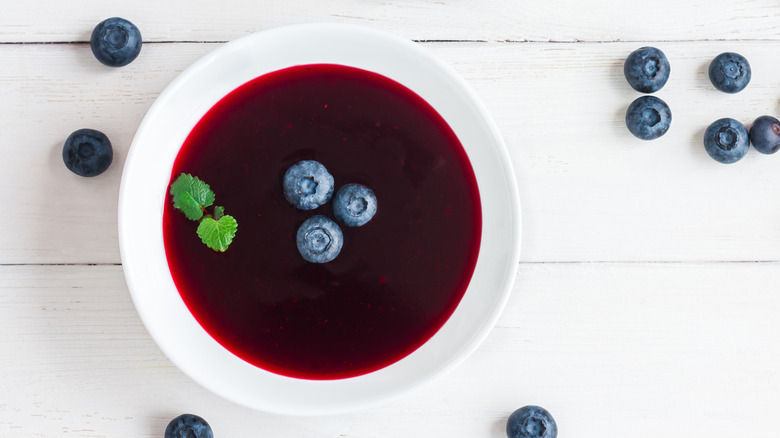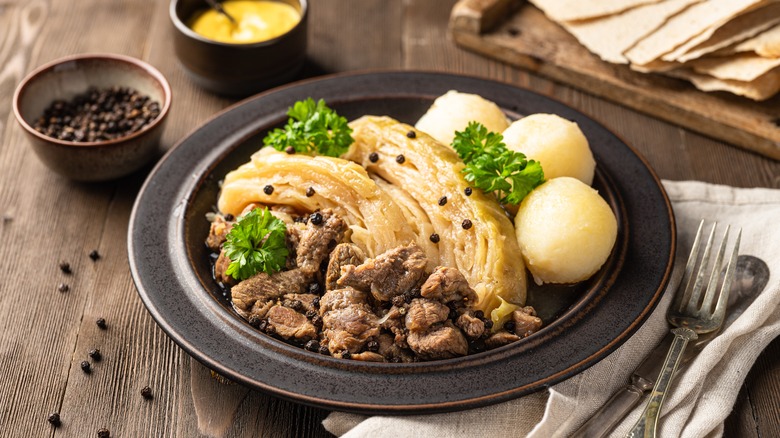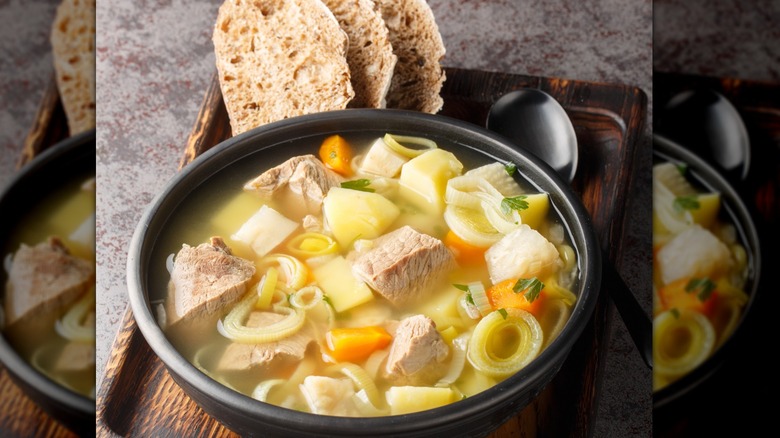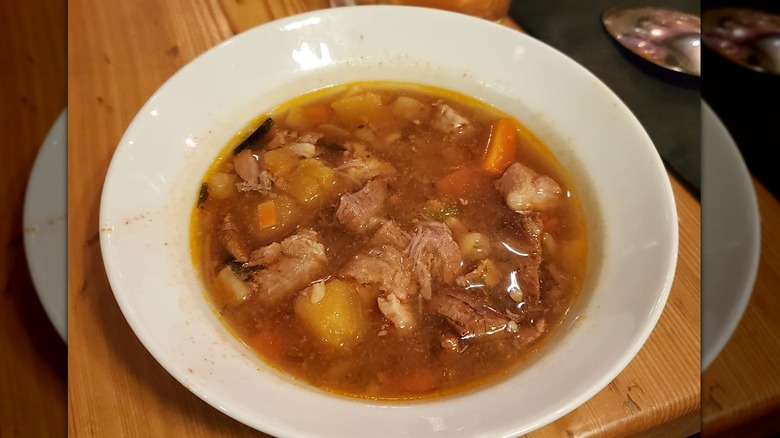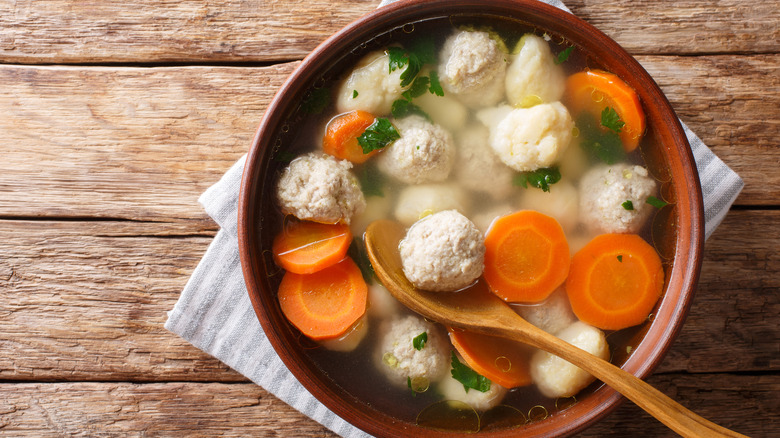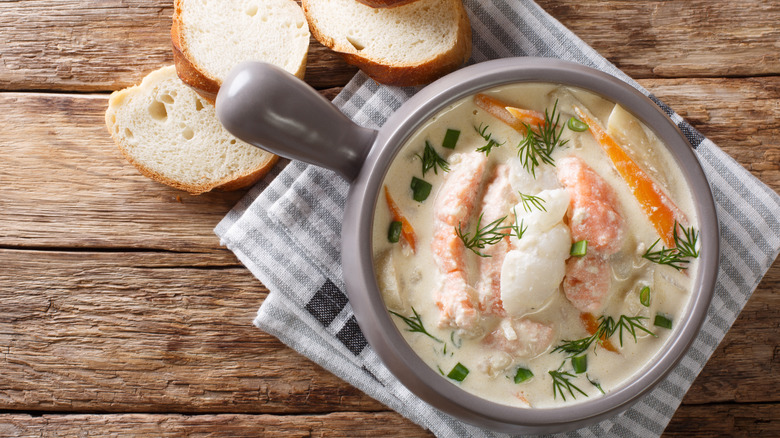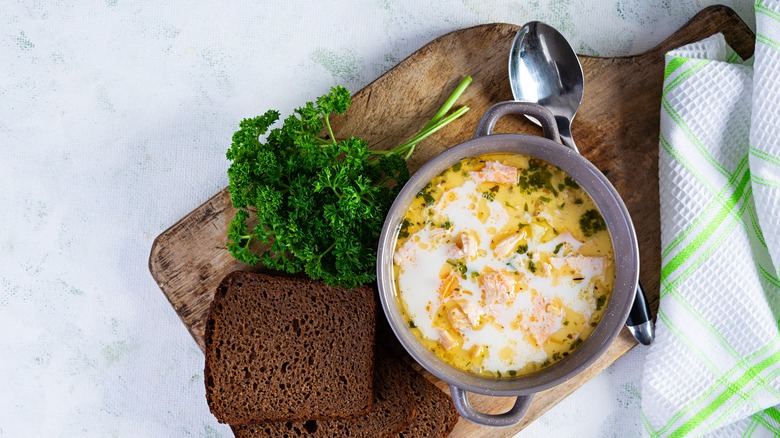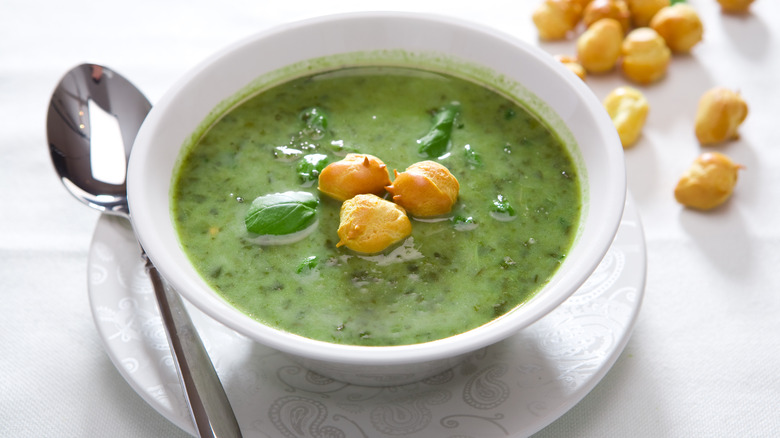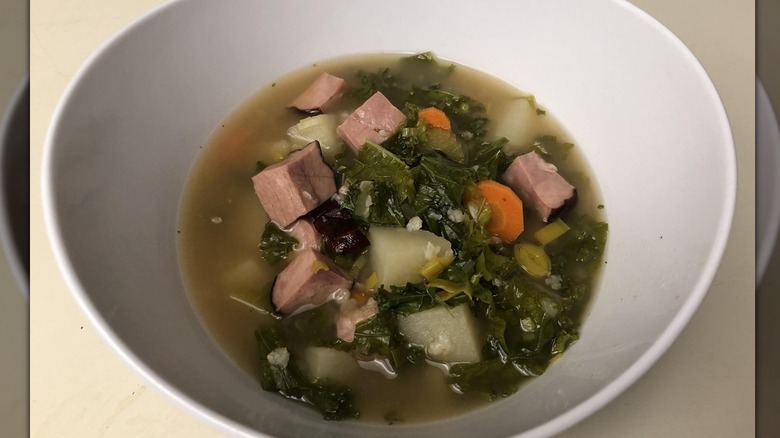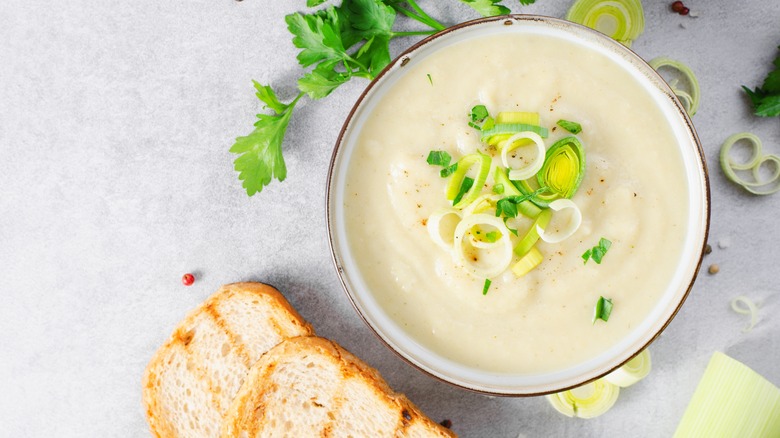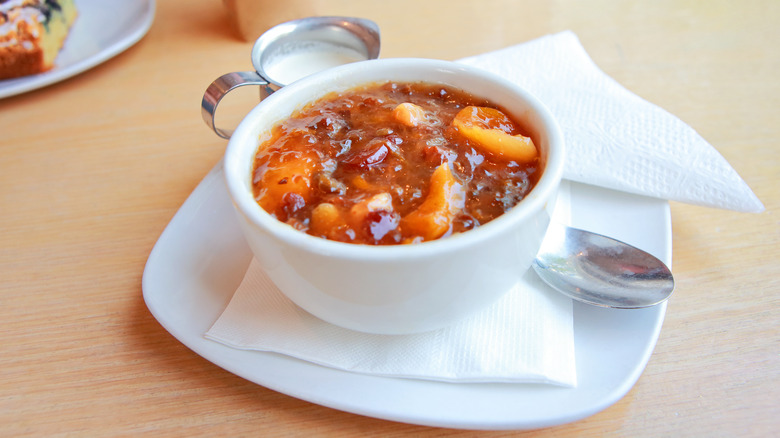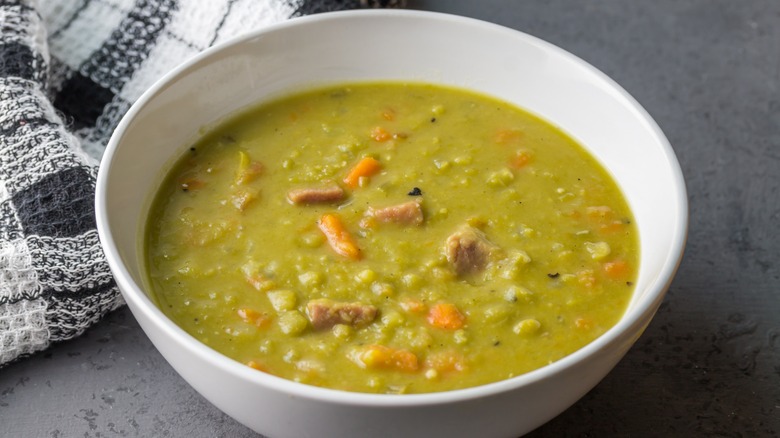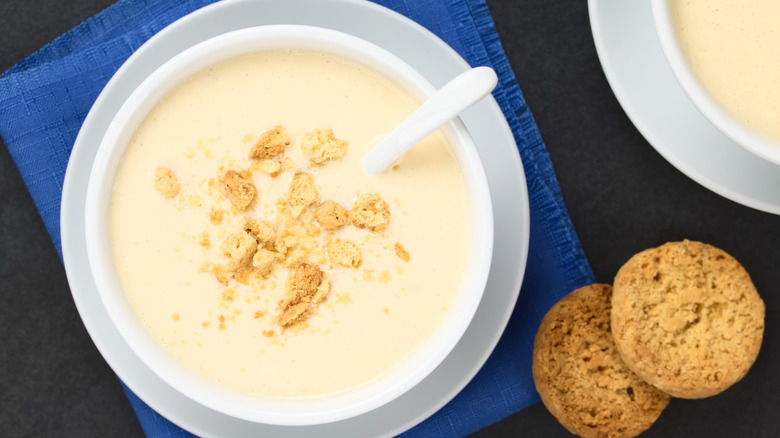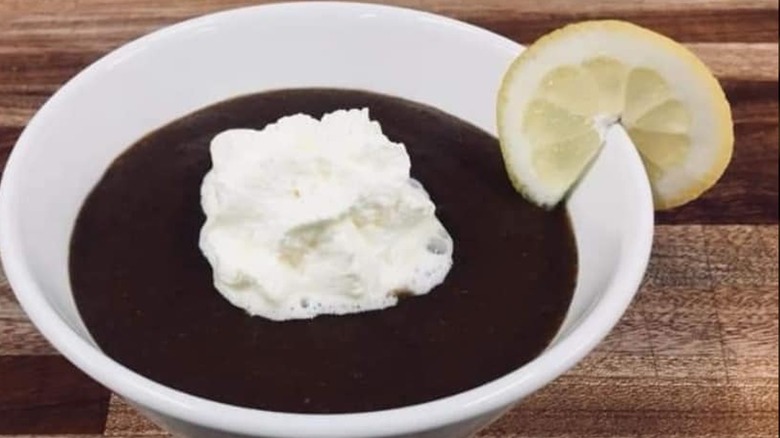14 Soups From Scandinavia You Should Know About
Depending on who you ask, Scandinavia includes some combination of Denmark, Norway, Sweden, Finland, Iceland, and the Faroe Islalads. While there's some debate about which countries make up this region of the world, one thing is for sure — Scandinavia is full of awe-inspiring landscapes and natural wonders. Dramatic fjords cascade into crystalline waters, the northern lights dance in the night sky, and volcanic hot springs promise respite from the crisp air. Yet despite its breathtaking scenery, Scandinavia's harsh climate and rocky terrain limit the variety of crops that can thrive. Nevertheless, Nordic cuisine thrives on ingenuity, relying on root vegetables, wild berries, bountiful seafood, and locally raised lamb.
From these humble ingredients, Nordic cooks have crafted an astonishing array of soups that capture the essence of the region's food culture. From hearty meat-based varieties and nourishing vegetable options to sweet types made with fruit and buttermilk, discover some of the soul-warming soups that highlight what Scandinavian gastronomy is all about. Not only will they zap the chill from your bones, but they'll captivate your senses and leave you daydreaming about one of the world's most magnificent regions long after the last spoonful.
Blåbärssoppa
Starting a list of Scandinavian soups with a sweet, fruity rendition might seem unusual, but Swedish blåbärssoppa is a true Nordic icon deserving recognition. Traditionally made with bilberries, a type of wild European blueberry that's closely related to North American blueberries, blåbärssoppa is a simple and versatile soup. It can be served cold as a breakfast or dessert in summer or warm as a light meal in winter. As a testament to how much Swedes love blåbärssoppa, the hot version is served as a drink during Vasaloppet, the world's oldest and longest ski marathon.
Preparing this tasty soup couldn't be easier. The berries (blueberries can be used as a substitute) simmer with water and sugar until they begin to break down, whereupon cornstarch is added as a thickening agent. Some choose to leave the soup chunky, others use an immersion blender to smooth a portion of the berries, and still others blend it completely. As for serving, a dollop of whipped cream is always welcome, as are a couple of cinnamon sticks for those indulging in the hot version. Additionally, it's common to find blåbärssoppa served with small macaroons called mandelbiskvier.
Fårikål
Soup is typically seen as humble fare, often relegated to a supporting role as a starter or side dish. However, fårikål, a Norwegian stew made with mutton (or lamb) and cabbage, defies this norm. In 1972, fårikål, which translates to "mutton in cabbage," won the unofficial title of Norway's national dish during a radio survey. This title became official during a 2014 government vote where fårikål triumphed over meatballs with brown sauce to win the distinction.
The enduring appeal of fårikål is evident in Norway's celebration of Fårikål Feast Day, a holiday observed on the last Thursday of September. You might be wondering how such a simple dish could ascend to the highest echelon of Norwegian culinary tradition. The answer comes down to comfort and tradition. Fårikål-making season begins in autumn and serves as the unofficial start to the chilly, darker period of the year. Moreover, its main ingredients (lamb, cabbage, and potatoes) are cherished local products.
While fårikål is straightforward, there are variations. Some prefer a hearty stew with plenty of broth, while others opt to drain the lamb and cabbage pieces. Regardless of the approach, boiled potatoes typically accompany this beloved dish. As for drinks, Norwegians typically serve fårikål with ale, dark lager, white wine, or sour apple juice.
Köttsoppa
When winter temperatures plummet, comfort soups provide solace across different cultures. Americans savor tomato soup, the Japanese relish miso soup, and the Polish delight in zupa ogorkowa, a pickle soup enriched with pork stock and shredded veggies. Sweden also embraces this tradition with köttsoppa, a beef and root vegetable soup simmered to perfection in a clear broth.
Typically made with beef chuck or prime rib, köttsoppa occasionally features moose meat, especially in northern parts of the country. Along with the meat, a medley of root vegetables featuring celery root, parsnips, leeks, and potatoes adds depth and texture. Meanwhile, white peppercorns and bay leaves infuse the broth with a pleasant aroma.
However, it's the addition of klimp that truly distinguishes köttsoppa. These delectable dumplings, made from a blend of flour, milk, and egg, are chilled until firm, then sliced and nestled into bowls before being drenched with the rich beef soup. Swedes often complete the meal with knäckebröd, a crispy rye flatbread, and cheese.
Kjötsúpa
Kjötsúpa holds a special place in the hearts of Icelanders. In the Land of Fire and Ice, this lamb-based soup isn't just a meal — it's a remedy for chilly winter days, lingering hangovers, and nasty colds. Regardless of any healing properties it may or may not possess, Icelanders love kjötsúpa for its comforting warmth and nourishing qualities.
Featuring bone-in lamb shoulder or chops and root vegetables such as onion, turnip, potatoes, carrots, and white cabbage, this soup is seasoned simply with freshly ground pepper and salt. While the ingredient list may seem a bit unimaginative, Icelandic tradition demands keeping kjötsúpa simple. That means foregoing broth or stock and simmering the meat in water alone. When done right, the bone-in lamb provides plenty of flavor. It also means leaving additional seasonings out to preserve the soup's authentic taste.
Though tradition dictates simplicity, there are some acceptable variations. For instance, adding starchy elements like rice, pearl barley, or rolled oats is permitted. These ingredients serve to add further substance to the soup. Additionally, it's common practice to serve the lamb and potatoes separately, allowing diners to customize their portions before enjoying the soup.
Kød og melboller suppe
Certain foods are so irresistibly delicious that the idea of tampering with them seems not just risky, but downright unthinkable. Here, we're talking about classics like hamburgers, pizza, and pancakes. Meatballs and dumplings undoubtedly deserve a place on this list, however, Denmark has managed to do the unthinkable by combining these two foods and transforming them into an irresistible soup.
Known as kød og melboller suppe, or "meatball and dumplings soup," this creation brings together the best of both worlds — savory meatballs and comforting dumplings — along with chicken broth and vegetables like carrots, celery, and onions. Seasoned with parsley, thyme, salt, and pepper, this soup might have a tough-to-pronounce name, but its ingredients are simple enough for even the most novice home chefs. The dumplings require just water, unsalted butter, salt, flour, and eggs. Meanwhile, the meatballs are typically made with a blend of pork and veal, mixed with egg, flour, onion, milk, and seasonings. Everything comes together to form a hearty, nutritious meal requiring zero side dishes.
Fiskesuppe
As you might be able to guess by the name, fiskesuppe translates to "fish soup" in Norwegian. It's a fitting term for this creamy chowder that's loaded with at least two types of fish. Along with cod and Atlantic salmon, fiskesuppe features root vegetables such as carrots, potatoes, and leeks. While these resilient veggies are staples in Scandinavian soups, their distinctive feature in fiskesuppe lies in their cutting style — short, thin strips, rather than cubed pieces. This traditional technique not only sets the soup apart but also helps the vegetables cook more quickly. Fiskesuppe's creaminess comes from butter, flour, milk, and crème fraîche, with fish stock tying everything together.
In addition to the simple version of fiskesuppe, there's the Bergen variety, known as Bergensk fiskesuppe. Originating from Bergen, a town located on Norway's western coast, this version builds on the original salmon and cod base by incorporating halibut, monkfish tail, and additional seafood like shrimp. Another distinguishing element is the addition of vinegar for an added kick. Additionally, Bergensk fiskesuppe is often served with fiskepudding, which are homemade fish dumplings made from cod, egg, and corn flour.
Lohikeitto
Salmon may be considered a delicacy in some parts of the world, but Scandinavian countries are ahem...swimming in it. For that reason, this fatty, orangey-pink fish finds its way into a variety of dishes such as gravlax, salmon gratin, and salmon with potatoes and dill sauce. If you're lucky, you'll also chance upon lohikeitto, a creamy fish chowder starring salmon as the main ingredient. A point of precision before we continue: This soup is popular throughout Nordic countries. As a result, you'll see it referred to as laxsoppa in Sweden, and laksesuppe in Denmark. The names look different, but they all mean "salmon soup" and refer to the same rich, creamy creation.
Apart from salmon, lohikeitto features fish broth, leeks, russet potatoes, and carrots. The leeks are sauteed in butter, while the other vegetables are boiled with a generous amount of dill. Once cooked, the salmon chunks are reintroduced into the soup along with heavy cream, more dill, and a touch of allspice before serving. This quintessentially Nordic dish is typically enjoyed with pumpernickel or rye bread for dipping.
Spenatsoppa
Translated from Swedish, spenatsoppa means "spinach soup," a fitting name for this classic dish. This simple recipe features chopped frozen or fresh leaf spinach as the star ingredient, along with onion, garlic, and broth (either chicken or vegetable). Unlike some Scandinavian soups which adhere strictly to tradition, spenatsoppa welcomes experimentation. Variations may introduce potatoes, nutmeg, and cream for added richness. While the ingredients appear humble, spenatsoppa surprises with its depth of flavor and adaptability.
Not only is the ingredient list simple, but so is the preparation process. After sauteing onion and garlic in butter, spinach, and broth join the mix, simmering until the spinach wilts. Some recipes stop there, resulting in soup with a chunky texture, while others suggest blending until smooth with an immersion blender. Regardless of the approach, spenatsoppa effortlessly pairs with crusty bread, grilled cheese, or sliced boiled eggs, making it a delightful and satisfying meal suitable for any season.
Grønkaal
Celebrated for its versatility in salads, frittatas, and pasta dishes, curly leaf kale shines anew in Denmark's grønkaal (literally "kale"), a vegetable and meat soup ideal for banishing winter's chill. Everyone's favorite cruciferous vegetable gets a salty, umami blast from the addition of cooked ham or chopped pork hocks, while trusty root vegetables like potatoes, celery, carrots, and leeks come in to provide earthy notes and a satisfying texture.
At the heart of this dish lies the flavorful ham hock broth, which is slow-simmered for hours over low heat. Chicken broth can be used in a pinch, but skipping the homemade broth results in an inferior grønkaal soup experience. Along with the meat, aromatic garlic, zesty black pepper, and warming nutmeg season the broth to perfection. Quick-cooking rolled oats or flour are introduced just before serving and contribute a comforting thickness to this soul-warming dish. For the quintessential Danish touch, grønkaal is served with a dollop of whipped cream and a side of rye bread or sourdough for sopping up every last drop.
Blomkålsuppe
Exploring Scandinavian cuisine reveals striking parallels. Bound by their shared historical, cultural, and geographical bonds, these nations frequently exchange and recreate recipes. Take köttbullar, for example. Sweden gets all the credit for these delectable meatballs, but you'll find almost the same recipe in Norway's kjøttkaker. Or how about Finland's lohikeitto? Pretty much every Scandinavian country has its rendition of this beloved salmon chowder. Another dish shared amongst several Nordic countries is blomkålsuppe, a creamy cauliflower soup.
Interestingly, Norwegians and Danes use the same term for this velvety concoction, while Swedes call it blomkålssoppa and Finns refer to it as kukkakaalikeitto. Though the Scandinavian words are a mouthful, this soup is reminiscent of the cauliflower soup enjoyed by many Americans. Preparation involves simmering cauliflower with onions or shallots in vegetable or chicken broth until tender, then blending it to a smooth consistency and enriching it with cream. The simple base allows for plenty of experimentation when it comes to toppings, with bacon and croutons serving as popular options. True to the Scandinavian ethos, blomkålsuppe finds its culinary counterpart in crusty bread for dipping.
Søtsuppe
Although soup is typically a savory food, plenty of countries have sweet versions. For example, the Chinese enjoy hong dou tang, a dessert soup made with red beans and sugar. Meanwhile, Hungarians savor meggyleves, a sweet and sour cherry soup. Norway contributes its own unique sweet soup to this culinary category with søtsuppe (literally "sweet soup").
Søtsuppe features pearl tapioca, dried fruits (usually apples and raisins), sugar, cinnamon, star anise, and lemon juice. Norwegians eat søtsuppe hot or cold, making it a versatile snack, dessert, or breakfast any time of year. Preparing søtsuppe is a straightforward process that begins with soaking tapioca overnight. The remaining ingredients are added the following day. Slow simmering is key to perfect søtsuppe, as it helps maintain the shape and texture of the fruits. This soup offers plenty of room for creativity, as both the fruits and spices can be adjusted according to preference.
Ärtsoppa
While yellow split pea soup might not immediately pique your interest, Sweden's ärtsoppa is here to challenge your preconceptions. Along with humble yellow peas, this soup includes pork flank or ham hock, providing savory and umami flavors that elevate the otherwise unassuming legume. With that said, creating a vegetarian version is a breeze, as many recipes allow for a ham-free option without compromising on taste.
Diced onions and carrots complement the main ingredients, while thyme, marjoram, bay leaf, and allspice contribute warmth and earthiness. Simmered over medium heat for an hour or more, the soup gradually thickens to perfection. To further enhance the texture, some people mash the peas directly in the pot. Alternatively, it's possible to remove the meat, blend the soup, and reintroduce the chopped meat afterward. Swedish tradition calls for ärtsoppa to be served with mustard, dill, and rye bread, accompanied by a refreshing beverage like milk or beer to complete the experience.
Kærnemælksuppe
The name of this Danish soup is intimidating, but like many Scandinavian soups, the recipe is refreshingly simple. Kærnemælksuppe is a traditional warm buttermilk soup reminiscent of something your grandmother would prepare on a lazy weekend morning. It takes just a few minutes to throw together and proves itself as a versatile appetizer, breakfast, or dessert.
While classic, there are various ways to prepare it. One involves mixing half of the buttermilk with powdered vanilla pudding and sugar, while another opts for cornstarch, vanilla sugar, and whipping cream. Some even incorporate eggs beaten with sugar into the final product. Regardless of the method, sugar is an essential ingredient that helps offset the sourness of the buttermilk. After the ingredients come together, the soup is heated until it thickens. Lemon juice and zest are added just before serving for some zing. Finally, raisins, sliced almonds, or fresh fruit compote provide visual appeal and extra sweetness.
Brauðsúpa
In Scandinavia, rye bread is a dietary staple, not only benefiting digestive health, as confirmed by Healthline, but also occasionally leaving behind leftovers. Resourceful Icelanders found a solution to their excess bread conundrum in brauðsúpa, a sweet rye bread soup. The concept of bread soup may seem unconventional, but that's just the beginning of this intriguing recipe.
The preparation process involves cubing the bread and soaking the pieces in malt alcohol for several hours. Once saturated, the soggy bread is transferred to a pot with lemon juice and brought to a boil. Any residual clumps are whisked away, and water is added to thin the broth if needed. Next, lemon slices, raisins, cinnamon, and salt are incorporated to balance out the heavy flavor profile. Some home chefs may choose to add sugar, however many find the natural sweetness of the malt and rye sufficient. A dollop of whipped cream and a sprinkle of lemon zest is added as a final step, imparting sweet richness and a subtly sour note to the dark brown broth.
